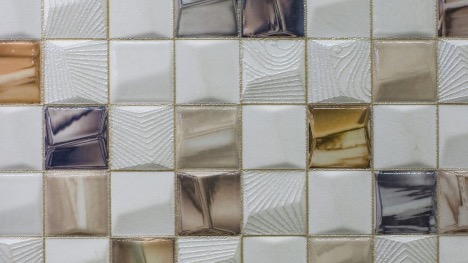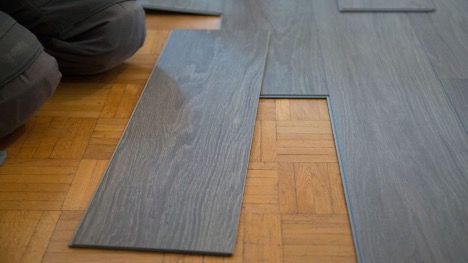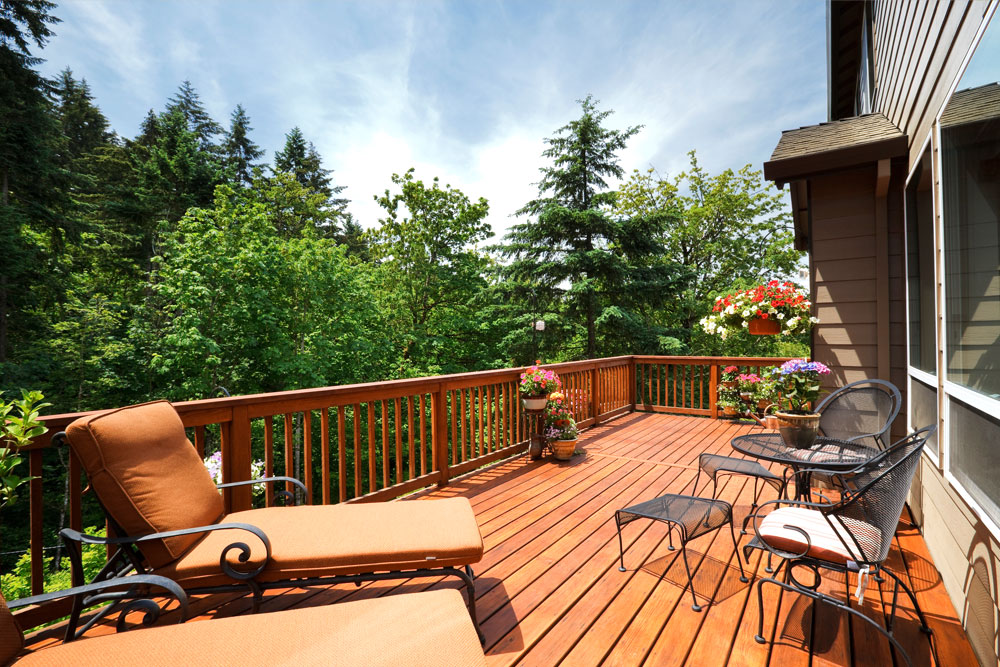No one type of flooring is ideal for every room. For example, hardwood is consistently popular because of its warm, classic look, but it doesn’t hold up well to moisture or rough treatment. Here’s a look at the pros, cons, and costs of several popular types of flooring, as well as some ideas about which are the best flooring options for specific areas.
Hardwood
Solid wood flooring comes in either strips, which range in width from 1.5 to 2.5 inches, or planks 4 to 8 inches wide. It can be made from many kinds of wood, from domestic species such as oak and maple to exotic varieties such as Brazilian cherry or purpleheart.
Wood flooring can be sold either finished or unfinished. If you choose unfinished flooring, you will need to sand and finish it after installing it. According to Consumer Reports, prefinished wood flooring typically costs less and involves less work. Also, the factory-installed finishes are usually more durable than anything you could do yourself.
Wood is a renewable resource, but it isn’t always harvested in sustainable ways. Cutting trees without planting new ones in their place, or cutting them faster than new ones can grow, contributes to global warming. If you want to be sure your wood floors come from sustainably managed forests, look for flooring certified by the FSC (Forest Stewardship Council) or the SFI (Sustainable Forestry Initiative). You can also look for reclaimed wood flooring, which has been recovered from old buildings that have been torn down, but it’s much harder to find and can be more expensive.
Advantages
People love solid wood flooring because it looks great in any style of home with any decor. It’s also very long-lasting since it can be refinished up to five times to remove surface scratches. Experts say adding hardwood floors can increase the resale value of your home as well. According to Realtor.com, homeowners who install new hardwood floors can expect to make back 70% to 80% of the cost when they sell.
Wood floors are fairly easy to clean; just sweep them regularly and mop up all spills promptly. And installing them yourself is a reasonably easy DIY project, allowing you to save money on the job.
Engineered Wood
Engineered wood flooring looks just like solid wood, but it’s made in a different way. It has a thin veneer of natural wood on top, showing the grain, with layers of less expensive plywood underneath. That makes engineered wood both cheaper and sturdier. According to HGTV, some types of engineered wood have even more stability with backing made from recycled wood fiber mixed with stone dust.
Like solid wood flooring, engineered wood comes in a wide variety of wood types, patterns, and board widths. In addition to strips and planks, you can choose parquet tiles, which have narrow strips of wood arranged in a geometric pattern atop a plywood or mesh base. Engineered hardwood can be nailed down like traditional wood flooring, glued down, or installed as a “floating” floor on top of a foam or cork underlayer. Some engineered wood flooring comes with a special tongue and groove system that clicks into place to form a tight seam without glue or nails.
Advantages
Engineered wood floors can give you the look of solid wood at a marginally lower price. That makes it easier to afford exotic woods such as tigerwood or Brazilian maple, which are more dent- and scratch-resistant. They’re more stable than solid wood and less sensitive to changes in temperature and humidity, making them a reasonable choice for a basement room, unlike solid wood.
Many types of engineered wood flooring can be installed directly over a concrete subfloor, something that isn’t always possible with solid wood. Some are even flat enough to install on top of old hardwood floors, saving you the work and expense of ripping out the old floor before installing the new one. And the clickable type of flooring is especially easy to install yourself, saving you even more on installation costs.
Bamboo
Bamboo is a fast-growing grass that can produce flooring with the look and feel of hardwood. It’s become popular recently as an eco-friendly alternative to wood flooring, but experts caution that it isn’t always a greener choice.
Just like hardwood, bamboo flooring is available in both solid strips and engineered planks. It comes in several different patterns that show the grain of the grass in different ways. Flat-grain bamboo flooring has darker stripes across the boards, showing the nodes in the bamboo; vertical-grain bamboo flooring has long, narrow strips packed tightly together; and end-grain bamboo has lots of little short strips.
Advantages
According to HomeAdvisor, bamboo flooring is more moisture-resistant than wood. Like engineered wood, it’s available in forms that are easy to install. It’s as easy to care for as solid or engineered hardwood flooring, and it’s easy to refinish.
Also, many people consider it a more eco-friendly alternative to wood flooring because bamboo grows much faster than most trees and absorbs carbon from the atmosphere more quickly.

Ceramic Tile
Ceramic tile is made from a mixture of clay and shale that’s fired in a kiln like pottery. It’s a hard material that comes in a huge variety of colors, shapes, and patterns. HGTV warns that not all ceramic tiles are tough enough for flooring, so it’s important to make sure the ones you buy are rated for use on floors.
There are four main types of ceramic tile:
- Glazed Ceramic. This type of tile has a glass-like coating that can give the tile virtually any color or texture. Glazed ceramic tile is practically maintenance-free.
- Porcelain. This tile is fired at very high temperatures, making it extra-hard and durable. It’s available either glazed or unglazed. Both types are stain-resistant and work well in outdoor rooms.
- Quarry Tile. This unglazed ceramic tile has a slightly rough texture, making it more slip-resistant than glazed tile. However, it’s not available in as wide a range of colors.
- Terracotta. This unglazed tile comes only in earth tones. It’s less durable than other tiles and needs regular sealing to prevent stains.
Advantages
Floor tile comes in many colors and shapes, so it can fit in with any style of home. Thanks to modern printing technology, it’s also possible to create ceramic tile with virtually any pattern. It can mimic the look of natural stone or even wood, though it won’t feel like wood underfoot.
Tests at Consumer Reports found porcelain tile to be the most durable type of flooring, resistant to scratches, dents, and moisture. It’s also very easy to clean. Glazed ceramic and porcelain tile require very little maintenance, though other types need more.
Laminate
Laminate flooring is constructed much like engineered wood, with a thin veneer over layers of plywood or compressed fiber. However, the top layer is not wood but a photograph under a clear plastic coating. That means laminate can look like wood, stone, tile, or just about any other material.
Laminate comes in either planks or tiles. Most of them are floating floor systems, which you can install right over your old flooring with no glue or nails.
Advantages
Laminate floors can mimic the look of wood or stone for much less money. They’re also easy to clean and require very little maintenance. Laminate is a hard material that resists scratches, dents, and stains, according to HomeAdvisor. It also cleans up easily and requires little maintenance.
Laminate is easy to install over an existing floor, saving you time and money on your flooring project. Consumer Reports says the material is easy to install yourself, but HGTV cautions that it takes “patience and ingenuity” to fit the planks around corners and through doors.

Vinyl
Vinyl is a type of resilient flooring, a flexible material that feels a bit softer underfoot than rigid wood or tile. It’s made from a layer of PVC (short for polyvinyl chloride) plastic over a layer of felt. Cushioned vinyl has a thin layer of foam as well, making it more comfortable to walk on. Thicker vinyl flooring can have a textured surface to make it look like wood or stone.
Vinyl flooring comes in several forms. Sheet vinyl is a large sheet of flooring that you unroll, cut to size, and glue to your subfloor. You can also buy luxury vinyl flooring, which clicks into place like engineered wood flooring, or vinyl tiles that you glue in place one at a time. Some vinyl tiles come with a peel-and-stick backing, so you don’t need to add any adhesive before laying them down.
Advantages
Vinyl is a tough material that stands up to both moisture and heavy foot traffic. It’s comfortable to walk on and warmer on bare feet than tile. It’s also inexpensive and durable; according to HGTV, a good-quality vinyl floor can last 20 years.
Like tile, vinyl comes in a wide range of colors and patterns. It can convincingly simulate the look of almost any other material. A flooring dealer interviewed by Consumer Reports says customers often assume the luxury vinyl planks on her showroom floor are real wood.
Plank vinyl and peel-and-stick tiles are easy to install, though sheet vinyl can be difficult. You can install vinyl over an existing vinyl floor as long as it only has one layer. Plank vinyl is also easy to repair – just remove and replace a damaged plank – and all types of vinyl flooring are very easy to clean.

Linoleum
Linoleum is another type of resilient flooring that’s been around since the 1880s, though it only became widely available in the 1940s. Unlike vinyl, it’s made from natural, renewable materials, including cork powder and linseed oil. For decades, it mostly disappeared from homes as vinyl became more popular. However, concerns about the chemicals in vinyl flooring have revived interest in this old-fashioned alternative.
Like vinyl flooring, linoleum is available in sheets, tiles, or laminated planks that you can install as a floating floor. Some linoleum comes with a protective coating to reduce wear and prevent stains; other types need to be refinished every couple of years.
Advantages
Linoleum flooring is even more durable than vinyl. According to the DIY Network, a linoleum floor can last up to 40 years with proper care. It’s easy to clean, and it doesn’t show scratches as much as vinyl since the pigment runs all the way through the material.
Like vinyl, linoleum feels soft underfoot and comes in a wide range of colors and styles. However, unlike vinyl, it’s an eco-friendly, biodegradable material that produces no harmful emissions. It’s also easy to install if you choose snap-together flooring.







